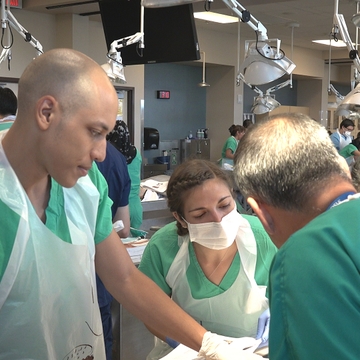New Mexico Approves Master of Science in Anesthesia Program at UNM

Embodied Education
Anatomical Donations Support UNM's Health Care Curriculum
Thirty-one bodies lie on steel tables in UNM's Anatomy Laboratory, naked save for their heads, hands and feet, which are shrouded in plastic wrap.
Second-year medical students clad in green surgical scrubs huddle around each table, chatting animatedly as they take turns using scissors and scalpels to dissect body parts while consulting anatomy textbooks. Today, they're exploring the abdominal cavity, learning to identify the elements of the gastrointestinal tract.
Hands-on experience in the anatomy lab is an enduring rite of passage for medical students, says Amy Rosenbaum, director of UNM's Anatomical Donations Program. "It's like learning a new language," she says. "They're familiarizing themselves with structures."
Students discover that each human body is unique, sometimes diverging in significant ways from the idealized illustrations presented in textbooks. "It's absolutely fascinating," Rosenbaum says. "Everyone's different on the inside."
The lab, operated through the UNM School of Medicine's Department of Cell Biology & Physiology, relies on donated bodies, she says. About 60 are needed each year for medical students and resident physicians, as well as students in UNM's physical therapy and physician assistant programs.
Many of the donors are people from health care backgrounds who grasp the importance of supporting medical education. "There is a section of the population that really understands the need and will donate, no matter what," Rosenbaum says.
Others choose to donate to spare the expense of a funeral, she says. All donors must sign notarized documents willing their bodies to the School of Medicine. After students finished with their studies, the bodies are cremated and the remains returned to their families.
Rosenbaum often engages hospice nurses in her quest to ensure that enough cadavers are on hand for the start of the new school year. "They do an eloquent job of really speaking to the person about what's happening," she says.
The average age of donors is about 80 (the oldest was 105), she says. Deaths are due to diverse causes, including brain tumors, cancers of various kinds, heart disease and chronic obstructive pulmonary disease.
People who direct in their wills that their bodies should be donated "to science" might not realize that in practice, their bodies will likely wind up in a commercial facility that sells organs and body parts to laboratories for research. UNM is different, Rosenbaum says. "Our goal is education."
Rosenbaum, who grew up in a small town in Oklahoma, volunteered at the local funeral home in high school and went on to earn a college degree with a minor in funeral service. She worked at an Albuquerque funeral home before joining UNM in 2005.
"Funeral service is about the dead, but it's for the living - there is a lot of human interaction in it," she says. "When I was in the funeral home, we were putting people back together to make them presentable. Here, we're taking them apart to see what makes them tick."
The lab, on the second floor of the Domenici Center for Health Sciences Education, is a state-of-the-art facility that opened in 2010. It includes an embalming room and features down-draft ventilation at each table that helps keep the bodies moist while suctioning off most of the fumes from embalming fluid.
Rosenbaum says the heads, hand and feet are kept covered at the beginning of the semester for a reason. "It kind of takes away the fear of the first dissection," she says. "We don't want to scare them on the first day. We want to make it as clinical as possible." The wrappings come off as the students become more comfortable working in the lab.
When class is in session, the atmosphere is surprisingly matter-of-fact - even cheery - with the students deeply absorbed in their work. Paul McGuire and Rebecca Hartley, faculty members in Cell Biology & Physiology, circulate among the tables, answering questions and guiding the dissections.
At one station, Sabah Osmani, Rachel Fleddermann, Rachel Baca and Carolyn Ice are poised over a cadaver illuminated by an overhead surgical lamp. A textbook, a printed-out dissection guide and an iPad loaded with anatomical illustrations are at the ready as discuss their findings. They have all had prior experience in the lab, although they admit some experiences can still be unsettling.
"There are parts that are more difficult than others," confesses Osmani, a member of UNM's Combined BA/MD Program. "For me, the hardest part wasn't the face - it was the hands - holding a hand and cutting it."
Fleddermann likes to remind herself that each body was donated to the lab for a reason. "You have to remember this was their plan," she says. "This was what they wanted."